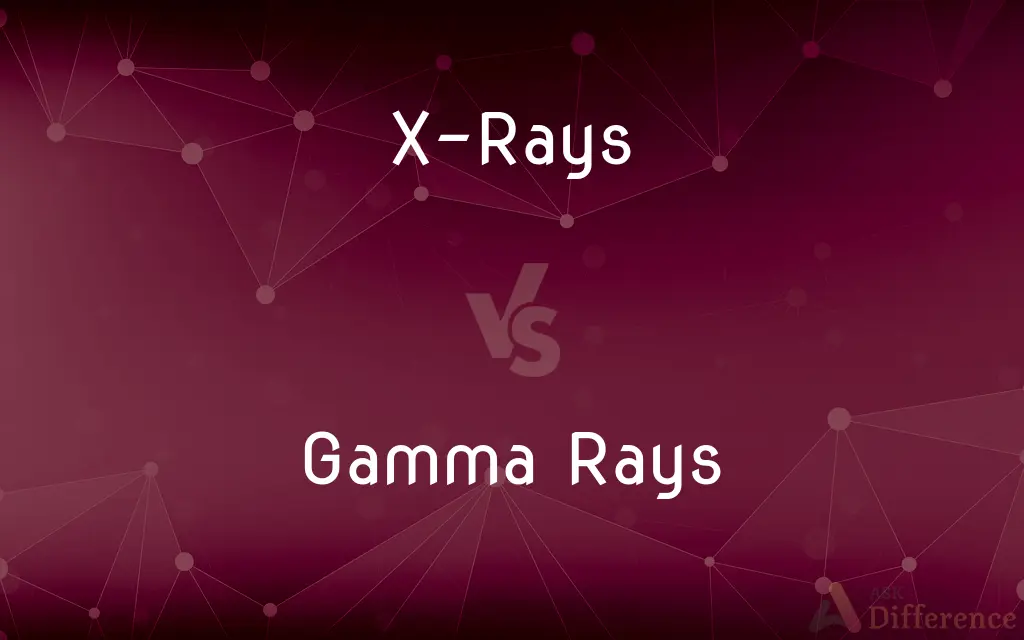X-Rays vs. Gamma Rays — What's the Difference?
By Tayyaba Rehman — Published on December 2, 2023
X-Rays is electromagnetic waves used for imaging bones; Gamma Rays is high-energy radiation from radioactive decay.

Difference Between X-Rays and Gamma Rays
Table of Contents
ADVERTISEMENT
Key Differences
X-Rays are electromagnetic waves primarily used in medical imaging to view internal structures. Gamma Rays are highly penetrating electromagnetic radiation arising from radioactive decay or other nuclear and subatomic processes. Both are on the electromagnetic spectrum, but they differ in origin and applications.
X-Rays, discovered by Wilhelm Conrad Roentgen, have wavelengths ranging from 0.01 to 10 nanometers. Gamma Rays, discovered by Paul Villard, are shorter in wavelength, below 0.01 nanometers. While X-Rays are generated by accelerating electrons, Gamma Rays originate from the nucleus of an atom.
In medical applications, X-Rays are commonly used for diagnostic purposes such as checking for broken bones. Gamma Rays, due to their higher energy, are used in treatments like radiotherapy for cancer. Both X-Rays and Gamma Rays have industrial applications, but their use requires careful handling due to potential health hazards.
X-Rays interact with matter mainly through ionization and can be absorbed or scattered. Gamma Rays, being more energetic, have higher penetration power and require denser materials like lead for shielding. Despite these differences, both X-Rays and Gamma Rays have revolutionized scientific and medical fields.
Comparison Chart
Discovery
Discovered by Wilhelm Conrad Roentgen in 1895.
Discovered by Paul Villard in 1900.
ADVERTISEMENT
Wavelength
Range from 0.01 to 10 nanometers.
Less than 0.01 nanometers.
Origin
Produced by accelerating electrons or decelerating charges.
Emitted from the nucleus of an atom or subatomic processes.
Penetration Power
Moderate, can be stopped by dense materials like lead.
High, requires denser shielding like lead or concrete.
Applications
Used for medical imaging, such as bone fractures.
Used in cancer therapy and sterilization.
Compare with Definitions
X-Rays
X-Rays are used to capture images of internal body structures.
The doctor used X-Rays to diagnose the broken bone.
Gamma Rays
Gamma Rays are a high-energy form of electromagnetic radiation.
Gamma Rays are more energetic than X-Rays.
X-Rays
X-Rays assist in diagnosing various conditions.
A chest X-Ray can help diagnose pneumonia.
Gamma Rays
Gamma Rays are emitted during radioactive decay.
Gamma Rays are detected coming from radioactive materials.
X-Rays
X-Rays are employed in scientific and industrial research.
Scientists use X-Rays to study crystal structures.
Gamma Rays
Gamma Rays are used in radiotherapy for cancer treatment.
Gamma Rays targeted the tumor precisely during treatment.
X-Rays
X-Rays are a form of electromagnetic radiation.
X-Rays pass through soft tissues but are absorbed by bones.
Gamma Rays
Gamma Rays are used for sterilizing medical equipment.
Gamma Rays effectively sterilize surgical tools.
X-Rays
A photon of electromagnetic radiation of very short wavelength, ranging from about 10 down to 0.01 nanometers, and very high energy, ranging from about 100 up to 100,000 electron volts.
Gamma Rays
Gamma Rays are observed in astronomical phenomena.
Astronomers detected Gamma Rays from a distant supernova.
X-Rays
Often x-rays or X-rays A narrow beam of such photons. X-rays are used for their penetrating power in radiography, radiology, radiotherapy, and scientific research. Also called roentgen ray.
X-Rays
A photograph taken with x-rays.
X-Rays
The act or process of taking such a photograph
Did the patient move during the x-ray?.
X-Rays
To irradiate with x-rays.
X-Rays
To photograph with x-rays.
X-Rays
Plural of x-ray
X-Rays
Infl of x-ray
X-Rays
X-Rays are used for security scanning.
Airport security uses X-Rays to check luggage for prohibited items.
Common Curiosities
How were X-Rays discovered?
Wilhelm Conrad Roentgen discovered X-Rays in 1895 while experimenting with cathode rays.
Who discovered Gamma Rays?
Paul Villard discovered Gamma Rays in 1900 while studying radiation.
What are Gamma Rays?
Gamma Rays are high-energy electromagnetic radiation from radioactive decay or other nuclear processes.
What are X-Rays?
X-Rays are a form of electromagnetic radiation used primarily in medical imaging.
What is the wavelength of Gamma Rays?
Gamma Rays have wavelengths shorter than 0.01 nanometers.
What are the medical uses of X-Rays?
X-Rays are used for diagnosing fractures, dental issues, and other internal medical conditions.
What is the typical wavelength of X-Rays?
X-Rays have wavelengths ranging from 0.01 to 10 nanometers.
Can X-Rays be harmful?
Yes, excessive exposure to X-Rays can be harmful and lead to radiation sickness or cancer.
Why do Gamma Rays require heavy shielding?
Due to their high energy and penetration power, Gamma Rays require dense materials like lead or concrete for shielding.
How are Gamma Rays produced?
Gamma Rays originate from the nucleus of an atom or subatomic processes.
Can X-Rays penetrate through metals?
X-Rays can penetrate some metals but are absorbed by denser materials like lead.
How are X-Rays produced?
X-Rays are produced by accelerating electrons or decelerating charges.
How are Gamma Rays used in medicine?
Gamma Rays are used in cancer therapy and sterilization of medical equipment.
Do X-Rays and Gamma Rays have industrial applications?
Yes, both are used in non-destructive testing, material analysis, and security scanning.
Are Gamma Rays dangerous?
Yes, Gamma Rays are highly penetrating and can be harmful if not properly shielded.
Share Your Discovery

Previous Comparison
Primary Active Transport vs. Secondary Active Transport
Next Comparison
Ginger Ale vs. Ginger BeerAuthor Spotlight
Written by
Tayyaba RehmanTayyaba Rehman is a distinguished writer, currently serving as a primary contributor to askdifference.com. As a researcher in semantics and etymology, Tayyaba's passion for the complexity of languages and their distinctions has found a perfect home on the platform. Tayyaba delves into the intricacies of language, distinguishing between commonly confused words and phrases, thereby providing clarity for readers worldwide.














































